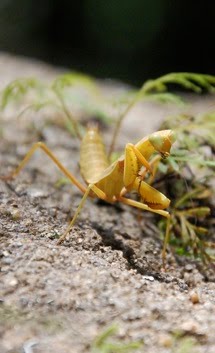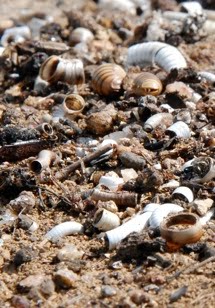Merry Malagasy Christmas









 This is a ruler. Correction...this is the ruler. This brass bar was the exact length of King Louis XVI's foot. This meant people could make copies of this ruler and measure things exactly. Which is nice. Or at least certainly better than dragging the King of France around everywhere and holding his foot up to measure things. I'm sure the King would agree.
This is a ruler. Correction...this is the ruler. This brass bar was the exact length of King Louis XVI's foot. This meant people could make copies of this ruler and measure things exactly. Which is nice. Or at least certainly better than dragging the King of France around everywhere and holding his foot up to measure things. I'm sure the King would agree.  And here is that very first meter. The one, the only, the official meter of France (and most of the world now too). If you had 9,999,999 more platinum bars to go with this one you could put them end-t0-end and stretch them from the cold north pole all the way to the sweaty equator.
And here is that very first meter. The one, the only, the official meter of France (and most of the world now too). If you had 9,999,999 more platinum bars to go with this one you could put them end-t0-end and stretch them from the cold north pole all the way to the sweaty equator.  And it wasn't just length the French decided to clear up in 1799. They tackled weight too. This is the first official kilogram. I nice change from the pound which used to be equal to the weight of 7,000 barley seeds. Not 6,999 tiny barley seeds. Not 7,001 tiny barley seeds. But exactly 7,000 tiny barley seeds. Count carefully.
And it wasn't just length the French decided to clear up in 1799. They tackled weight too. This is the first official kilogram. I nice change from the pound which used to be equal to the weight of 7,000 barley seeds. Not 6,999 tiny barley seeds. Not 7,001 tiny barley seeds. But exactly 7,000 tiny barley seeds. Count carefully.


 At night, Caterpillar dreamed wonderful little caterpillar dreams. She chewed her way through big plates of tasty green salad. She crunched a big munchy apple until there was nothing left but the tiny tippy tip of the stem.
At night, Caterpillar dreamed wonderful little caterpillar dreams. She chewed her way through big plates of tasty green salad. She crunched a big munchy apple until there was nothing left but the tiny tippy tip of the stem. But her eggs would fly some day.
But her eggs would fly some day. 


 Even though this is the only place in the whole world that has lemurs hopping, leaping and dancing around, it is still pretty tough to find one. Most of the time you have to be happy with seeing other animals instead.
Even though this is the only place in the whole world that has lemurs hopping, leaping and dancing around, it is still pretty tough to find one. Most of the time you have to be happy with seeing other animals instead.
But for me, that's easy, I love insects. And insects are not hard to find here. Last weekend I went with my wife to help her office collect plants and replant trees in a forest very close to the Indian ocean. While walking along and looking for plants we came across plenty of fantastic six-legged creatures.
 This little girl looks like part shrimp and part grasshopper. How do I know it's a girl? Look at that long skinny needle coming out of her abdomen (butt). That's an ovum depositor. An egg laying tube in other words.
This little girl looks like part shrimp and part grasshopper. How do I know it's a girl? Look at that long skinny needle coming out of her abdomen (butt). That's an ovum depositor. An egg laying tube in other words.  But like all praying mantids, it is still a great hunter. And also like all praying mantids, it comes complete with wonderful camouflage.
But like all praying mantids, it is still a great hunter. And also like all praying mantids, it comes complete with wonderful camouflage.  Not every insect spends part of it's life as a caterpillar, but every insect does have six legs. Even caterpillars only have six. Flip one over next time and count the shoes. You'll find six shoes or legs in the front that all look about the same, short with little claws. And behind them you will find several sets of stumpy legs with suction cups on the end. Those act like legs, but they are not legs. They are fake legs and disappear when the larva pupates and pops out an adult.
Not every insect spends part of it's life as a caterpillar, but every insect does have six legs. Even caterpillars only have six. Flip one over next time and count the shoes. You'll find six shoes or legs in the front that all look about the same, short with little claws. And behind them you will find several sets of stumpy legs with suction cups on the end. Those act like legs, but they are not legs. They are fake legs and disappear when the larva pupates and pops out an adult. This katydid did do what katydids do do so well...it hid. Katydids eat leaves, but there are lots of things that eat them back, so they have to blend in while they enjoy their salads.
This katydid did do what katydids do do so well...it hid. Katydids eat leaves, but there are lots of things that eat them back, so they have to blend in while they enjoy their salads. You're exactly right, but that isn't a white puffy colony of fungus--it's an aphid! But if you want to hide, looking like a ball of untasty fungus is a neat trick. Look closely and you can see little black lines. Those are the legs. Yep, six of them.
You're exactly right, but that isn't a white puffy colony of fungus--it's an aphid! But if you want to hide, looking like a ball of untasty fungus is a neat trick. Look closely and you can see little black lines. Those are the legs. Yep, six of them. And here's the weirdest of them all. I stared at this little darling for awhile. I couldn't tell what it was. It walked like an ant, but there were no other ants around. And most ants love to be around their ant friends. It had six legs and three body parts, so it couldn't be a spider.
And here's the weirdest of them all. I stared at this little darling for awhile. I couldn't tell what it was. It walked like an ant, but there were no other ants around. And most ants love to be around their ant friends. It had six legs and three body parts, so it couldn't be a spider.






Three more photos that can't stop talking. Listen to their blabbing and see what you learn (or would that be hear what you learn?).






Click on the video below and see if you can answer the question:
What is it?
So, is it...















